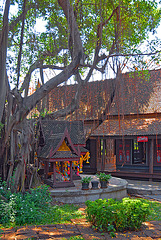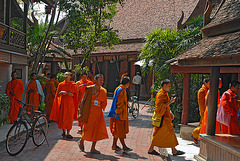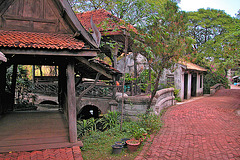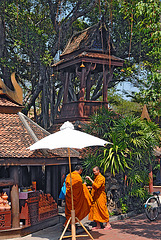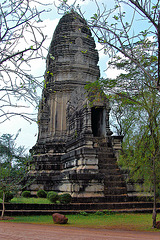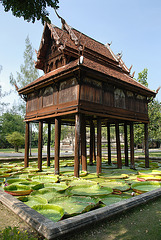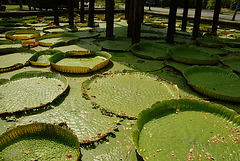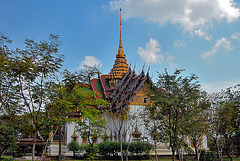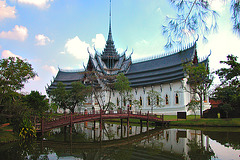
Mueang Boran, Ancient Siam, เมืองโบราณ
One of the richest Thais - Khun Lek Prapai Viriyaphant – Thailand’s largest importer of a German car brand, and a very influential citizen, is using his money to establish one of the biggest and most beautiful open-air museums on the world for the benefit of all Thais and foreigners.
Thailand has a population of 64 Mill., 2,3 % of which are incredible whealthy, but only very few of these rich peo…
(read more)
Backyard in the Thai Old Market Town ตลาดโบราณ
| |
|
It is important for the Thai people to draw in their natural surroundings by placing potted plants around the terrace, however, in the past there were strict taboos regarding which plants could be placed directly around the house (in current times these are often ignored for the sake of aesthetics).
The Old Market Town in Mueang Boran,
| |
|
The place depicts an old self-contained community consisting of various shops selling arts and craft, souvenirs and deserts. These old houses were originally from Yannawa district Bangkok, dismantled and rebuilt here.
Walking through the ancient Thai village
| |
|
Walking along the small way through the rebuilt Thai village gives an impression to every body that he is switched into the past 60 or 70 years ago.
The Old Market Town ตลาดโบราณ
| |
|
On visiting the site, travellers will be reminded of the spectacle of an ancient market town that was once vital in Thai communities.
Wooden bridge leading out the Old Market Town
| |
|
After the walk through the rebuilt Old Market Town the way goes other a rebuilt old wooden bridge to a Khlong (the Thai word for a water canal).
Paved way through the rebuilt old village
| |
|
Every thing till the detail is rebuilt in original style even this paved road through the village. When you're visiting the museum you get the feeling being switched 80 years back to the Thai past tense.
Drum tower in Ancient Siam หอระฆัง
| |
|
As communication to the local residents Thais used a drum or a bell in the past to call the citizen come to the temple for meditation.
At the present overturned loudspeakers do the same in every village, starting 5.30 a.m.
Drum tower in Ancient Siam
| |
|
The drum tower still is used in some Thai villages calling the citizen to come to the monastery or temple for their meditation. Usually a novice is climbing up to the tower to beat the drum.
Stupa of Phra Maha That, Ratchaburi พระปรางค์วัดพ…
| |
|
The Stupa of Phra Maha That, Ratchaburi Province represents Mahayana Buddhism and was constructed during the Lop Buri period which dates to around the 11th-13th century A.D. The brick central tower stands on a laterite base. The structure has been renovated and restored several times. The murals in the chamber of the prang were made during the early Ayutthaya period while the stuccos and ornaments on the upper part of the prang were executed by both Ayutthaya and Rattanakosin craftsmen.
Phra Maha That, Ratchaburi situated at Muang Boran is a three-fourths scaled model of the original structure.
Bell tower หอระฆัง
| |
|
In the past, the scripture repository is normally raised on piles over a pond to protect the palm leaf manu scripts from ants and termites. The build ing of this type can hardly be found any where in Thailand today. The one at Muang Boran has been built and preserved for posterity.
The repository was brought from Wat Yai, Bang Khonthi in Samut Songkhram Province. Its original building, standing in a pond at Wat Yai, was much dilapidated. The structure is likely modeled after the Ayutthaya architectural style. The walls on the outside are invaluable old murals of the Life of the Buddha which are painted with tempera sketches gilded with gold. The murals are faded now.
The Buddha Image of Dvaravati Period ว…
| |
|
Nakhon Chai Si, an ancient city, is located in Nakhon Pathom Province, prospered be tween the 7th-11th century A.D. The city was presumably the most important city of the Dvaravati Period which dominated central Thailand. A large number of religious monuments discovered here have shown the unique artistic style inspired by Hinayana Buddhism, which predominated in the king dom at that time. The unique art style found in Dvaravati became known later as Dvaravati civilization. The pro found influence of Dvaravati art can be seen from many historical religious monuments in the central region, the south, the north and the northeast of Thailand.
One of the outstanding characteristics of Dvaravati civilization is gigantic Buddha images in the teaching posture-seated with his feet resting on the floor. Four are presently found in Thai land and housed in four different places: the ordination hall at Phra Pathom Chedi Monastery; the platform south of the chedi; the National Museum, Bangkok; and the Chao Sam Phra Ya National Museum, Ayutthaya Province.
Wat Thung Si Muang from Ubon Ratchathani วัดทุ่งศร…
| |
|
|
Wat Thung Si Muang was constructed during the reign of Rama III (1824-1851) to house a replica of the Buddha's footprint. Perhaps its most beautiful feature is the wooden tripitaka library (Ho Trai) that sits on stilts in a pond. It was designed in such a way to prevent insects (ants and termites) from reaching the palm scroll materials inside. The architecture is a mixture of Lao and Rattanakosin styles (Rattanakosin refers to the era after 1782, when Bangkok was the capital of Thailand).
Alongside the tripitaka library is the Ho Phra Buddha Bot. Adjacent to that is the Viharn (secondary chapel).
Lotus leafs at the water surface
| |
|
The city Ubon Ratchathani in Thailand's northeastern part Isaan means "Royal Lotus City." In Mueang Boran as well as in Ubon Ratchathani hugh lotus leafs cover the surface of the water pool where inside is constructed on piles the teak wooden temple. The leafs are so big that kids could walk on them (but should not try it).
Wat Thung Si Muang วัดทุ่งศรีเมือง from Ubon Ratch…
| |
|
Wat Thung Si Muang was constructed during the reign of Rama III (1824-1851) to house a replica of the Buddha's footprint. Perhaps its most beautiful feature is the wooden tripitaka library (Ho Trai) that sits on stilts in a pond. It was designed in such a way to prevent insects (ants and termites) from reaching the palm scroll materials inside. The architecture is a mixture of Lao and Rattanakosin styles (Rattanakosin refers to the era after 1782, when Bangkok was the capital of Thailand).
Alongside the tripitaka library is the Ho Phra Buddha Bot. Adjacent to that is the Viharn (secondary chapel).
Muang Boran obtained this building from the same monastery.
Dusit Maha Prasat Palace in the Grand Palace, Bang…
| |
|
In the early Rattanakosin era, the Dusit Maha Prasat Palace was an audience hall, where affairs of the state were con duct ed and royal ceremonies performed. The palace was built by King Rama I in 1806 A.D. The struc ture is a cruciform build ing with large high roofs. In the beginning, the palace was intended to be as large as the Suriyat Amarin Palace of Ayutthaya.
The Palace in the Grand Palace is now the only remaining example of the traditional Thai palace. Unfortunately, renovated in the reign of King Rama III, the building left no trace of the original workmanship initiated in the first reign.
The Grand Palace at Muang Boran, however, is not intended to model after the same palace as it stands today. By pains taking research and study of old photos and contemporary documents, Muang Boran has succeeded in recreating the original appearance of the palace.
Dusit Maha Prasat Palace in the Grand Palace, Bang…
| |
|
|
|
The elaborately or na ment ed porch facades conform with old pictures of the ancient Thai prasat building. The gilded lacquer work between the windows is styled after the paintings at Wat Nang Nong in Thon Buri, Bangkok. They show the yearly succession of state ceremonies which were recorded by King Rama V. More precisely, the murals depict events of a governmental, religious, military and diplomatic nature and the tradition al Thai way of life, Muang Boran has established these tempera murals to foster a revival of the techniques and styles used in traditional Thai mural paintings which have steadily been dying out since the King Rama III.
Sanphet Prasat Palace in Ayutthaya
| |
|
|
The Sanphet Prasat Palace was the principal palace in the early Ayutthaya period. It was initially built in the reign of King Baromatrai Lokanat, the eighth king of Ayutthaya. He succeeded in designing a unique architectural style that obviously differed from the preceding Khmer and Sukhothai styles. The dis tinc tive artistic style was later known as the Ayutthaya school which ap peared in many parts of the Sanphet Prasat Palace: the sweep of the basement, the tapering pillars, the elaborate pinnacle or na ments, the pedimented door and win dow frames and the over lap ping roof slopes.
The Palace was used in many important court and state ceremonies. For example, it served as a reception hall to receive many foreign dignitaries. The palace was completely renovated in the reign of King Baromakot (1732-1758 A.D.). Unfortunately, when Ayutthaya fell to Burma in 1767 A.D., the stately palace was burnt to the ground. Only its raised brick base ment remains today. Muang Boran has rebuilt the Sanphet Prasat Palace based on archaeological and historical evidence left by Thai and foreign historians. Also, research was conducted on the ruins to assemble a draft plan of the building. The detailed design and ornaments of the building were executed based on historical remains and documents as well. A proper study on the design of the interior had also been carried out. The result is superb magnificence.
Inside the Sanphet Prasat Palace in Ayutthaya
| |
|
The Overall Structure and Decorations of the Building
The cruciform of Sanphet Prasat Palace is formed by the core of the building, a tall cube rabbeted at each angle, and two wings adjacent to both sides of the central hall. The front and back wings are in fact large halls, but the effect is that of porches abutting a central tower. The largest porch, i.e., the front hall, was for the military and government while the rear hall was for the women of the palace. The other two porches on the left and right are quite short.
The raised basement carries lotus mouldings which dip in the middle and, like the hall of a sailing ship, rise at the ends.
Jump to top
RSS feed- Latest items - Subscribe to the latest items added to this album
- ipernity © 2007-2024
- Help & Contact
|
Club news
|
About ipernity
|
History |
ipernity Club & Prices |
Guide of good conduct
Donate | Group guidelines | Privacy policy | Terms of use | Statutes | In memoria -
Facebook
Twitter

